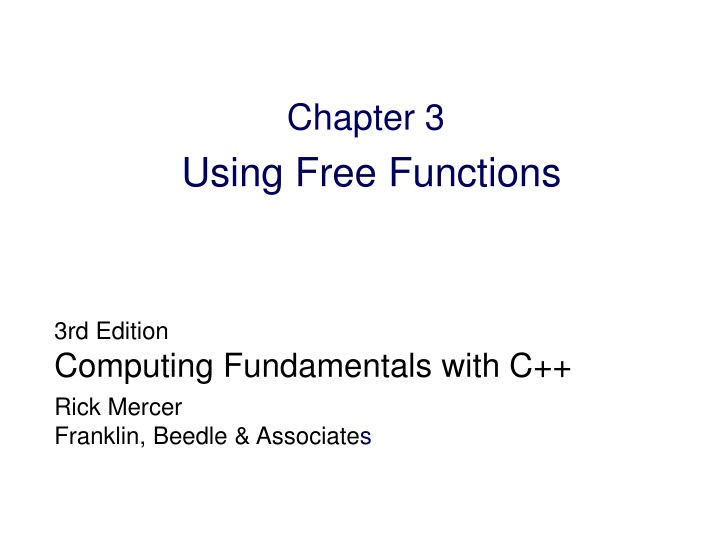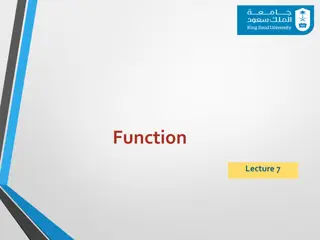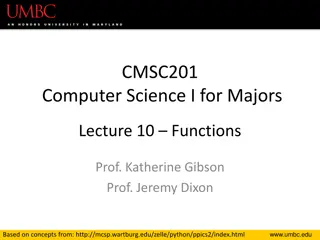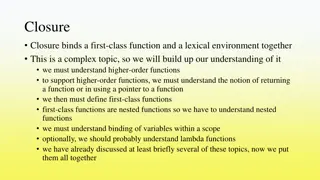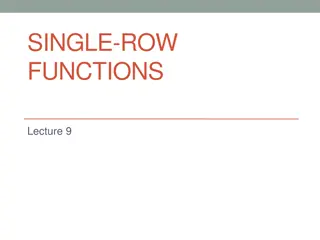Using Free Functions in Computing with C++
Discusses the utilization of free functions in C++ programming, evaluating mathematical and trigonometric functions, understanding function calls, and organizing software into functions. Covers key topics like using cmath functions, the pow function, function headings, and examples of some cmath functions.
Download Presentation

Please find below an Image/Link to download the presentation.
The content on the website is provided AS IS for your information and personal use only. It may not be sold, licensed, or shared on other websites without obtaining consent from the author.If you encounter any issues during the download, it is possible that the publisher has removed the file from their server.
You are allowed to download the files provided on this website for personal or commercial use, subject to the condition that they are used lawfully. All files are the property of their respective owners.
The content on the website is provided AS IS for your information and personal use only. It may not be sold, licensed, or shared on other websites without obtaining consent from the author.
E N D
Presentation Transcript
Chapter 3 Using Free Functions 3rd Edition Computing Fundamentals with C++ Rick Mercer Franklin, Beedle & Associates
Goals Evaluate some mathematical and trigonometric functions Use arguments in function calls Appreciate why programmers divide software into functions Read function headings so you can use existing functions
cmath functions C++ defines a large collection of standard math and trig functions such as sqrt(x) // return the square root of x fabs(x) // return the absolute value of x Functions are called by specifying the function name followed by the argument(s) in parentheses: cout << sqrt(4.0) << " " << fabs(-2.34); To use mathematical functions, you must #include <cmath> // For ceil, floor, pow
The pow function The pow function returns the first argument to the second argument's power pow(2.0, 3.0) returns 2 to the 3rd power (23 = 8.0) #include <cmath> // For the cmath functions #include <iostream> using namespace std; int main() { double base, power; base = 2.0; power = 4.0; cout << pow(base, power) << endl; cout << pow(-2, 3) << endl; return 0; }
Function Headings Can understand how to use a function if you see the function heading General form type functionName (type arg1, type arg2, ) One function heading double pow(double base, double power) Comments example function calls also help pow(5.0, 3.0) // evaluates to 125
Some cmath functions double ceil(double x) double cos(double x) double fabs(double x) Absolute value of x double floor(double x) Largest integer <= x double round(double x) Nearest integer to x double sin(double x) double sqrt(double x) Smallest integer >= x ceil(2.1) Cosine of x radians 3.0 0.5403 cos(1.0) fabs(-1.5) 1.5 floor(2.9) 2.0 round(1.5) 2 sin(1.0) Sine of x radians Square root of x sqrt(4.0) 2.0 0.84147
Evaluate some Function Calls Different arguments cause different return values ceil(0.1)_____ sqrt(16.0)_____ ceil(1.1)_____ sqrt(sqrt(16))_____ pow(2.0, 3)_____ fabs(-1.2)_____ sqrt(4.0)_____ floor(3.99)_____
Rounding to n decimals Code that rounds x to n decimal places using the pow and floor functions x = 456.789; n = 2; x = x * pow(10, n); // x ________ x = x + 0.5; x = floor(x); // x ________ x = x / pow(10, n); // x ________ // x ________
Calling Documented Functions C++ has many free functions available Programmers can write their own free functions to develop programs Functions are more easily understood when documented with comment Functions may also include pre- and post- conditions next slide
Preconditions and Postconditions C++ comments that represents a contract between the implementers of a function and the user (client) of that function Precondition What the function requires to be true when called Postcondition What the function will do if the precondition(s) is/are met
Pre: and Post: conditions The preconditions are the circumstances that must be true in order for the function to successfully fulfill the postconditions Example Precondition abbreviates topre: double sqrt(double x) // pre: x >= 0 // post: Returns square root of x sqrt(-1.0) evaluates to nan (not a number)
Function Headings A function heading is the complete declaration of a function without its implementation (sometimes called the function's signature). For example, this signature tells us how to call the function, but not how it works: double sqrt(double x)
Function Headings General form of a function heading: return-typefunction-name(parameter-list) return-type is any C++ type e.g.double int string function-name is any valid C++ identifier that is not reserved parameter-list is a set of 0 or more parameters General form for declaring parameters: class-name identifier Examples double f(double x) int max(int j, int k) string duplicate(string str, int n)
Argument/Parameter Associations Example call to max shows that arguments match parameters by position double max(double x, double y) cout << max(3.0, -5.32); The value of the 1st argument is copied to the 1st parameter, the value of the 2nd argument to the 2nd parameter, and so on, like assignments: x = 3.0; y = -5.32;
char and bool types C++ has two other primitive types that are used as the return types or parameters: char and bool bool type functions return 0 if the function returns false or a non-zero for true (usually 1) #include <cctype> // isdigit isalpha #include <iostream> using namespace std; int main() { cout << isdigit('9') << endl; // 1 cout << isdigit('X') << endl; // 0 cout << isalpha('A') << endl; // 1 cout << isalpha('<') << endl; // 0 return 0; }
char and int The toupper and tolower functions convert a char to its lower case or upper case equivalent Because the return type for both is int instead of char, the functions need to be cast to char with the code (char) to see the character toupper('a') // 65 (char) toupper('a') // A tolower('A') (char) tolower('A') // a // 97
Summary Documented function headings provide the following information: The type of value returned by the function The function name The number of arguments to use in a call The type of arguments required in the function call Pre- and post-conditions tell us what the function will do if the preconditions are met
